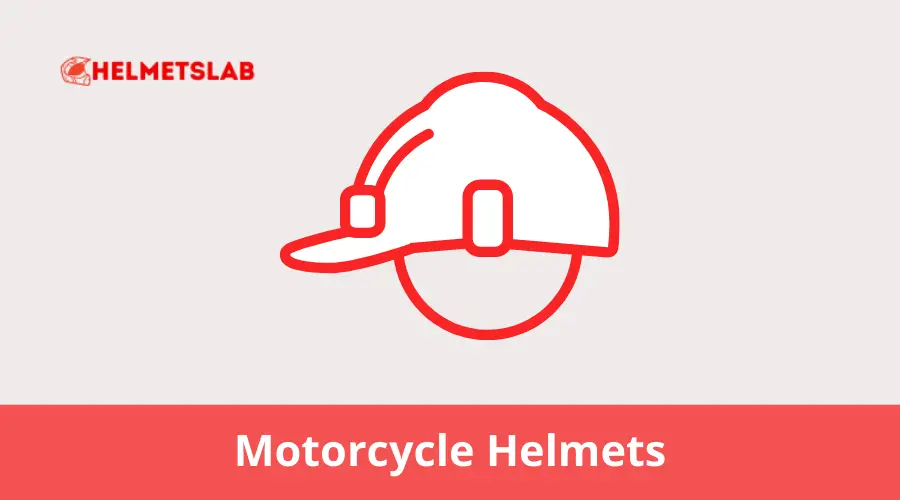Whether it’s motorcycling or bicycling, wearing proper gear is essential for any rider. But what happens when you don’t have the specific gear? Say, for example, you have a motorcycle helmet but want to ride a bicycle or vice versa.
The main difference between motorcycle riders is that they shouldn’t wear a bicycle helmet as it cannot provide the same level of protection, and a bicycle rider shouldn’t wear a motorcycle helmet as it doesn’t provide the same level of freedom and mobility. In some places, it is even illegal to interchange the two.
In this article, we will detail what differentiates the two helmets.
Motorcycle Helmets
Motorcycle helmets must be durable and heavy-duty to protect the rider from a motorcycle accident.

For this reason, motorcycle helmets are rigorously tested. These tests vary from country to country, but in general, there are four standards for a motorcycle helmet:
- DOT: The US Department of Transportation has declared this standard. The motorcycle helmets used in the US should all meet this standard. This standard is currently in effect in the FMVSS 218.
- ECE: The Economic Commission for Europe uses this standard for more than 50 countries. The current standard followed by the ECE is the ECE 22.05
- FIM: This standard is used by all FIM Endurance World Cup races and tracks.
- SNELL: Similar to DOT standards but has more rigorous testing. Unlike the rest, Snell testing and certification are voluntary.
Types of Motorcycle Helmets
Motorcycle helmets can be divided into six different categories based on the level of protection they provide:
- Full-faced Helmets
- Open-faced Helmets
- Half Helmets
- Modular or flip-up Helmets
- Off-road, Motocross, or Dirt Bike Helmets
- Enduro, Hybrid, or Adventure Helmets
The Full-faced, off-road, modular, and enduro motorcycle helmets provide high protection. In contrast, the open-faced and half-helmets will provide less protection as they give the user greater mobility.

Bicycle Helmets
A bicycle helmet is designed to be lightweight and provide cooling and airflow. The main focus of safety is to protect against impact. Despite that being the main focus, the limit of protection during impact can often be exceeded.
The US Consumer Product Safety Commission(CPSC) states that all bicycle helmets manufactured after 1999 must meet the 16 CFR part 1203 safety standard for bicycle helmets.
Bicycle helmets must also undergo safety tests, although not as rigorous as motorcycle helmets. Bicycle helmets must go through drop tests, impact resistance tests, chin strap tests, and additional tests before certification.
Certified bicycle helmets will have a label on them similar to motorcycle helmets.
Types of Bicycle Helmets
Bicycle helmets usually are not classified into different categories, but based on the level of protection they provide, they can be classified into 3 different categories:
- Road and Commuter Helmets
- Trail Helmets
- Enduro Helmets
All bicycle helmets provide limited protection and cover only the top of your head. Enduro helmets usually offer the best protection, followed by trail helmets. Road and commuter helmets provide the least amount of protection.
Motorcycle Helmets vs Bicycle Helmets impact protection
A helmet cannot protect a rider in every possible situation but is designed to protect them in the most common situations a rider might experience.
Most helmets are tested at speeds of 20 to 30 mph. Both motorcycles and bicycles can exceed that speed. Tests are carried out at these speeds because they represent the largest percentile of users.
The most severe crashes a motorcyclist or a bicyclist can encounter are collisions with other motor vehicles. In these cases, the injuries and fatalities suffered by motorcyclists and cyclists are the same.
Thus, helmets do have their limitations even during impact. After all, we can only do so much with something as small as a helmet.
The peak acceleration, ‘g’, is measured during impact tests. This g is the most important factor in determining the outcome of a crash. The larger the number of g, the more fatal the crash is.
Forces below 50g are considered safe, but between 50g and 100g will leave you with minor injuries. Forces of 200g are known to cause serious injuries and are, at times, fatal.
The usual force a helmet needs to protect you against is around 95g. This is the amount of force that leaves you with a concussion.
Motorcycle helmets are designed to sustain a blow of 100g with no injuries to the head. A bicycle helmet is designed to withstand 95g as a worst-case scenario. In most accidents, a bicycle helmet is designed to protect you from those below 50g.
This is why motorcycle riders shouldn’t wear bicycle helmets while riding a motorcycle.
Motorcycle Helmet vs Bicycle helmet mobility and freedom
Based on the previous argument, a motorcycle helmet provides more protection than a bicycle helmet. Still, bicyclists shouldn’t use a motorcycle helmet cause it poses a greater risk.
For starter motorcycles, helmets have very little ventilation compared to bicycle helmets. As cyclists have to drive the vehicle physically, they end up with insufficient cooling, which results in fatigue.
The motorcycle helmet covers the whole head and, at times, the face. This narrows down the vision of the wearer, and as a cyclist, it is a safety hazard when cycling down a busy road.
Motorcycle helmets are much heavier than bicycle helmets, which makes it harder for the wearer to keep their balance while paddling and also causes fatigue when on a long ride.
This is why bicyclists shouldn’t wear motorcycle helmets.
Final Words
Nothing is physically stopping you from wearing a motorcycle helmet while riding a bicycle or a bicycle helmet while riding a motorcycle. However, should you?
The answer is no! You shouldn’t.
Both helmets were specially designed for each helmet. In case of an emergency, you can use the helmets interchangeably, but don’t use them for a prolonged period.
Helmetslab is a website that focuses on providing in-depth reviews and information about different types of helmets, including motorcycle helmets and others helmets. I am writing a post with proper research on the info that helps helmet users.

